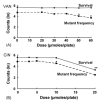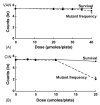Inhibition of spontaneous mutagenesis by vanillin and cinnamaldehyde in Escherichia coli: Dependence on recombinational repair
- PMID: 16999979
- PMCID: PMC2099251
- DOI: 10.1016/j.mrfmmm.2006.08.006
Inhibition of spontaneous mutagenesis by vanillin and cinnamaldehyde in Escherichia coli: Dependence on recombinational repair
Abstract
Vanillin (VAN) and cinnamaldehyde (CIN) are dietary antimutagens that effectively inhibit both induced and spontaneous mutations. We have shown previously that VAN and CIN reduced the spontaneous mutant frequency in Salmonella TA104 (hisG428, rfa, DeltauvrB, pKM101) by approximately 50% and that both compounds significantly reduced mutations at GC sites but not at AT sites. Previous studies have suggested that VAN and CIN may reduce mutations in bacterial model systems by modulating DNA repair pathways, particularly by enhancing recombinational repair. To further explore the basis for inhibition of spontaneous mutation by VAN and CIN, we have determined the effects of these compounds on survival and mutant frequency in five Escherichia coli strains derived from the wild-type strain NR9102 with different DNA repair backgrounds. At nontoxic doses, both VAN and CIN significantly reduced mutant frequency in the wild-type strain NR9102, in the nucleotide excision repair-deficient strain NR11634 (uvrB), and in the recombination-proficient but SOS-deficient strain NR11475 (recA430). In contrast, in the recombination-deficient and SOS-deficient strain NR11317 (recA56), both VAN and CIN not only failed to inhibit the spontaneous mutant frequency but actually increased the mutant frequency. In the mismatch repair-defective strain NR9319 (mutL), only CIN was antimutagenic. Our results show that the antimutagenicity of VAN and CIN against spontaneous mutation required the RecA recombination function but was independent of the SOS and nucleotide excision repair pathways. Thus, we propose the counterintuitive notion that these antimutagens actually produce a type of DNA damage that elicits recombinational repair (but not mismatch, SOS, or nucleotide excision repair), which then repairs not only the damage induced by VAN and CIN but also other DNA damage-resulting in an antimutagenic effect on spontaneous mutation.
Figures





Similar articles
-
Antimutagenicity of cinnamaldehyde and vanillin in human cells: Global gene expression and possible role of DNA damage and repair.Mutat Res. 2007 Mar 1;616(1-2):60-9. doi: 10.1016/j.mrfmmm.2006.11.022. Epub 2006 Dec 18. Mutat Res. 2007. PMID: 17178418 Free PMC article.
-
The antimutagenic effect of vanillin and cinnamaldehyde on spontaneous mutation in Salmonella TA104 is due to a reduction in mutations at GC but not AT sites.Mutat Res. 2001 Sep 1;480-481:55-69. doi: 10.1016/s0027-5107(01)00169-5. Mutat Res. 2001. PMID: 11506799
-
Post-replication repair and recombination in uvrA umuC strains of Escherichia coli are enhanced by vanillin, an antimutagenic compound.Mutat Res. 1988 Sep;201(1):107-12. doi: 10.1016/0027-5107(88)90116-9. Mutat Res. 1988. PMID: 3047569
-
Detection of natural bioantimutagens and their mechanisms of action with bacterial assay-system.Mutat Res. 1998 Jun 18;402(1-2):51-7. doi: 10.1016/s0027-5107(97)00281-9. Mutat Res. 1998. PMID: 9675243 Review.
-
Antimutagenesis by factors affecting DNA repair in bacteria.Mutat Res. 1988 Dec;202(2):387-91. doi: 10.1016/0027-5107(88)90200-x. Mutat Res. 1988. PMID: 3057369 Review.
Cited by
-
Antimutagenicity of cinnamaldehyde and vanillin in human cells: Global gene expression and possible role of DNA damage and repair.Mutat Res. 2007 Mar 1;616(1-2):60-9. doi: 10.1016/j.mrfmmm.2006.11.022. Epub 2006 Dec 18. Mutat Res. 2007. PMID: 17178418 Free PMC article.
-
Overview of the Role of Vanillin on Redox Status and Cancer Development.Oxid Med Cell Longev. 2016;2016:9734816. doi: 10.1155/2016/9734816. Epub 2016 Dec 19. Oxid Med Cell Longev. 2016. PMID: 28077989 Free PMC article. Review.
-
Vanillin modulates activities linked to dysmetabolism in psoas muscle of diabetic rats.Sci Rep. 2021 Sep 21;11(1):18724. doi: 10.1038/s41598-021-98158-7. Sci Rep. 2021. PMID: 34548565 Free PMC article.
-
Vanillin Suppresses Cell Motility by Inhibiting STAT3-Mediated HIF-1α mRNA Expression in Malignant Melanoma Cells.Int J Mol Sci. 2017 Mar 1;18(3):532. doi: 10.3390/ijms18030532. Int J Mol Sci. 2017. PMID: 28257048 Free PMC article.
-
Directed molecular screening for RecA ATPase inhibitors.Bioorg Med Chem Lett. 2007 Jun 15;17(12):3249-53. doi: 10.1016/j.bmcl.2007.04.013. Epub 2007 Apr 10. Bioorg Med Chem Lett. 2007. PMID: 17499507 Free PMC article.
References
-
- Ohta T, Watanabe K, Moriya M, Shirasu Y, Kada T. Analysis of the antimutagenic effect of cinnamaldehyde on chemically induced mutagenesis in Escherichia coli. Mol Gen Genet. 1983;192:309–315. - PubMed
-
- Ohta T, Watanabe K, Moriya M, Shirasu Y, Kada T. Antimutagenic effects of cinnamaldehyde on chemical mutagenesis in Escherichia coli. Mutat Res. 1983;107:219–227. - PubMed
-
- Ohta T, Watanabe M, Watanabe K, Shirasu Y, Kada T. Inhibitory effects of flavourings on mutagenesis induced by chemicals in bacteria. Food Chem Toxicol. 1986;24:51–54. - PubMed
-
- Ohta T, Watanabe M, Shirasu Y, Inoue T. Post-replication repair and recombination in uvrA umuC strains of Escherichia coli are enhanced by vanillin, an antimutagenic compound. Mutat Res. 1988;201:107–112. - PubMed
-
- Ohta T. Modification of genotoxicity by naturally occurring flavorings and their derivatives. Crit Rev Toxicol. 1993;23:127–146. - PubMed
Publication types
MeSH terms
Substances
Grants and funding
LinkOut - more resources
Full Text Sources
Miscellaneous

